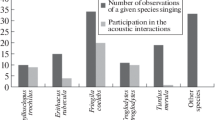Abstract
Birds do not always vocalize at random, but may rather divide up soundspace in such a manner that they avoid overlap with the songs of other bird species. In effect, a high degree of communication efficiency can be achieved by many simultaneously active vocalists that finely integrate songs with minimal overlap. We describe this phenomenon from several recordings at our principal study location, near Volcano, California. The most-studied models for conceptualizing and studying such de-synchronized systems come from scheduling algorithms in computer science, where internet protocols involve packets of information that are broadcast widely; any collisions between them will corrupt the colliding packets so that they need to be resent. We have simulated some of these methods that might be appropriate for the soundspace of bird communities. Some features of these de-synchronized depend on specifics of the algorithms used.




Similar content being viewed by others
Explore related subjects
Discover the latest articles, news and stories from top researchers in related subjects.References
Cody ML, Brown JH (1969) Song asynchrony in neighboring bird species. Nature 222(5195):778–780
Ficken RW, Ficken MS, Hailman JP (1974) Temporal pattern shifts to avoid acoustic interference in singing birds. Science 183(4126):762–763
Popp JW, Ficken RW, Reinartz JA (1974) Short-term temporal avoidance of interspecific acoustic interference among forest birds. Auk 102(4):744–748
Catchpole CK, Slater PJB (1995) Bird song: biological themes and variations. Cambridge University Press, London
Kirschel ANG, Cody ML, Harlow Z, Promponas VJ, Vallejo EE, Taylor CE (2011) Territorial dynamics of Mexican Antthrushes revealed by individual recognition of their songs. Ibis 153:255–268
Degesys J, Rose I, Patel A, Nagpal R (2007) DESYNC: self-organizing desynchronization and TDMA on wireless sensor networks. In: Tarek FA, Leonidas JG, Matt W (eds) Proceedings of the sixth international conference on information processing in sensor networks (IPSN2007), Cambridge, MA, USA, 25–27 Apr 2007, pp 11–20
Acknowledgments
We thank Leonard Kleinrock for his suggestions. This work was supported in part by NSF grant IIS-1125423 and the Excellent Young Researcher Overseas Visit Program of the Japan Society for the Promotion of Science, and Grant-in-Aid for Scientific Research (KAKENHI 24500168).
Author information
Authors and Affiliations
Corresponding author
About this article
Cite this article
Suzuki, R., Taylor, C.E. & Cody, M.L. Soundspace partitioning to increase communication efficiency in bird communities. Artif Life Robotics 17, 30–34 (2012). https://doi.org/10.1007/s10015-012-0014-8
Received:
Accepted:
Published:
Issue Date:
DOI: https://doi.org/10.1007/s10015-012-0014-8




